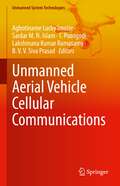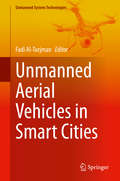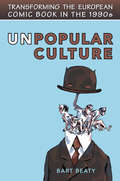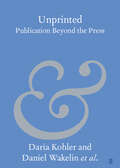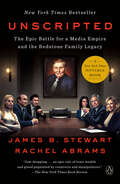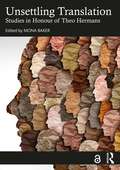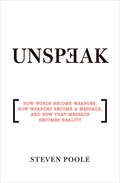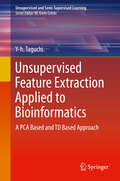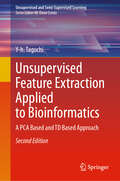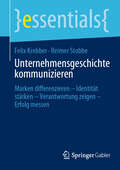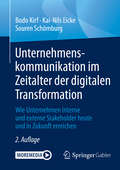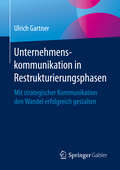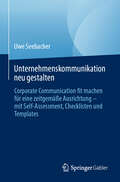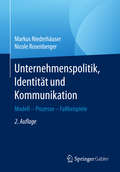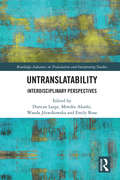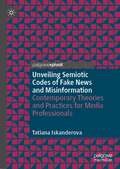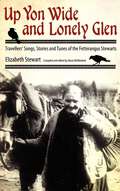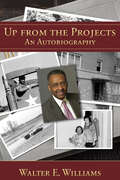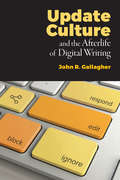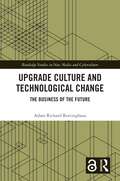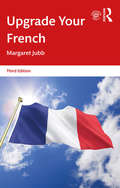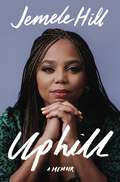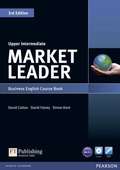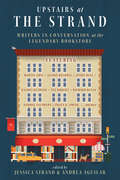- Table View
- List View
Unmanned Aerial Vehicle Cellular Communications (Unmanned System Technologies)
by Sardar M. N. Islam T. Poongodi Agbotiname Lucky Imoize Lakshmana Kumar Ramasamy B. V. V. Siva PrasadThe book discusses how Unmanned Aerial Vehicles (UAVs) can leverage the sub-6 GHz massive MIMO to address cell selection and interference issues in future wireless networks. The book takes a close look at utilizing UAVs to achieving direct and efficient device-to device (D2D) communications in the sky. Also, the key 6G enablers (cell-free architectures, artificial intelligence, reconfigurable intelligent surfaces, THz communications, and non-terrestrial networks) for UAV communication are broached, and the primary technological challenges of each enabler are discussed extensively. Furthermore, the book covers the design of adaptable UAVs to operate in diverse and harsh environmental conditions. Additionally, the existing UAVs’ networking protocols and how these can be greatly enhanced to address the issue of intermittent network changes and channel impairments are discussed. The prospects and societal benefits envisioned in future UAVs are also presented.
Unmanned Aerial Vehicles in Smart Cities (Unmanned System Technologies)
by Fadi Al-TurjmanThis book addresses the major challenges in realizing unmanned aerial vehicles (UAVs) in IoT-based Smart Cities. The challenges tackled vary from cost and energy efficiency to availability and service quality. The aim of this book is to focus on both the design and implementation aspects of the UAV-based approaches in IoT-enabled smart cities’ applications that are enabled and supported by wireless sensor networks, 5G, and beyond. The contributors mainly focus on data delivery approaches and their performability aspects. This book is meant for readers of varying disciplines who are interested in implementing the smart planet/environments vision via wireless/wired enabling technologies.Involves the most up to date unmanned aerial vehicles (UAV) assessment and evaluation approachesIncludes innovative operational ideas in agriculture, surveillance, rescue, etc.Pertains researchers, scientists, engineers and practitioners in the field of smart cities, IoT, and communicationsFadi Al-Turjman received his Ph.D. from Queen’s University, Canada. He is a full professor and a research center director at Near East University, Nicosia. He is a leading authority in the area of IoT and intelligent systems. His publication history spans over 250 publications in addition to his editorialship in top journals such as the IEEE Communication Surveys and Tutorials, and the Elsevier Sustaibable Cities and Society.
Unpopular Culture: Transforming the European Comic Book in the 1990s
by Bart BeatyIn the last fifteen years or so, a wide community of artists working in a variety of western European nations have overturned the dominant traditions of comic book publishing as it has existed since the end of the Second World War. These artists reject both the traditional form and content of comic books (hardcover, full-colour 'albums' of humour or adventure stories, generally geared towards children), seeking instead to instil the medium with experimental and avant-garde tendencies commonly associated with the visual arts. Unpopular Culture addresses the transformation of the status of the comic book in Europe since 1990. Increasingly, comic book artists seek to render a traditionally degraded aspect of popular culture un-popular, transforming it through the adoption of values borrowed from the field of 'high art.' The first English-language book to explore these issues, Unpopular Culture represents a challenge to received histories of art and popular culture that downplay significant historical anomalies in favour of more conventional narratives. In tracing the efforts of a large number of artists to disrupt the hegemony of high culture, Bart Beaty raises important questions about cultural value and its place as an important structuring element in contemporary social processes.
Unprinted: Publication Beyond the Press (Elements in Publishing and Book Culture)
by Daria Kohler Daniel Wakelin Natascha Domeisen Daniel Haywood Edward Jones Micah Mackay Rosie Maxton Brian M. Moore Katie Noble Felix M. Simon Daniel WojahnThis Element explores the idea of publication in media used before, alongside, and after print. It contrasts multiple traditions of unprinted communication in their diversity and particularity. This decentres print as the means for understanding publication; instead, publication is seen as an heuristic term which identifies activities these traditions share, but which also differ in ways not reducible to comparisons with printing. The Element engages with texts written on papyrus, chiselled in stone, and created digitally; sung, proclaimed, and put on stage; banned, hidden and rediscovered. The authors move between Greek inscriptions and Tibetan edicts, early modern manuscripts and AI-assisted composition, monasteries and courts, constantly questioning the term 'publication' and considering the agency of people publishing and the publics they address. The picture that transpires is that of a colourful variety of contexts of production and dissemination, underlining the value of studying 'unprinted' publication in its own right.
Unscripted: The Epic Battle for a Media Empire and the Redstone Family Legacy
by James B Stewart Rachel AbramsThe instant New York Times bestseller • A New York Times Notable Book • Named a Best Book of the Year by The Economist • Nominated for the Financial Times and Schroders Business Book of the Year Award"Addicted to Succession? Well, here's the real thing." - The Hollywood Reporter&“Jaw-dropping . . . an epic tale of toxic wealth and greed populated by connivers and manipulators.&” —The New York Times Book Review, Editors&’ ChoiceThe shocking inside story of the struggle for power and control at Paramount Global, the multibillion-dollar entertainment empire controlled by the Redstone family, and the dysfunction, misconduct, and deceit that threatened the future of the company, from the Pulitzer Prize–winning journalists who first broke the newsIn 2016, the fate of Paramount Global&’s entertainment empire hung precariously in the balance. Its founder and head, ninety-three-year-old Sumner M. Redstone, was facing a very public lawsuit brought by a former romantic companion, Manuela Herzer, which placed Sumner&’s deteriorating health and questionable judgment under a harsh light.As an all-powerful media mogul, Sumner had been a demanding boss, and an even more demanding father. When his daughter, Shari, took control of the business, she faced the hostility of boards who for years had heard Sumner disparage her. Les Moonves, the CEO of CBS, schemed with his allies on the board to strip Shari of power. But while he publicly battled Shari, news began to leak of Moonves&’s involvement in multiple instances of sexual misconduct, and he began working behind the scenes to try to make the stories disappear.Unscripted is an explosive and unvarnished look at the usually secret inner workings of two public companies, their boards of directors, and a wealthy, dysfunctional family in the throes of seismic changes. From the Pulitzer Prize– winning journalists James B. Stewart and Rachel Abrams, Unscripted lays bare the battle for power at any price—and the carnage that ensued.
Unsettling Translation: Studies in Honour of Theo Hermans
by Mona BakerThis collection engages with translation and interpreting from a diverse but complementary range of perspectives, in dialogue with the seminal work of Theo Hermans. A foundational figure in the field, Hermans’s scholarly engagement with translation spans several key areas, including history of translation, metaphor, norms, ethics, ideology, methodology, and the critical reconceptualization of the positioning of the translator and of translation itself as a social and hermeneutic practice. Those he has mentored or inspired through his lectures and pioneering publications over the years are now household names in the field, with many represented in this volume. They come together here both to critically re-examine translation as a social, political and conceptual site of negotiation and to celebrate his contributions to the field. The volume opens with an extended introduction and personal tribute by the editor, which situates Hermans’s work within the broader development of critical thinking about translation from the 1970s onward. This is followed by five parts, each addressing a theme that has been broadly taken up by Theo Hermans in his own work: translational epistemologies; historicizing translation; performing translation; centres and peripheries; and digital encounters. This is important reading for translation scholars, researchers and advanced students on courses covering key trends and theories in translation studies, and those engaging with the history of the discipline.
Unspeak: How Words Become Weapons, How Weapons Become a Message, and How That Message Becomes Reality (Books That Changed the World)
by Steven Poole“A sharply articulated, well-documented expos of the political and economic manipulation of language . . . Fans of Orwell, take heart.”—Kirkus ReviewsWhat do the phrases “pro-life,” “intelligent design,” and “the war on terror” have in common? Each of them is a name for something that smuggles in a highly charged political opinion. Words and phrases that function in this special way go by many names. Some writers call them “evaluative-descriptive terms.” Others talk of “terministic screens” or discuss the way debates are “framed.” Author Steven Poole calls them Unspeak. Unspeak represents an attempt by politicians, interest groups, and business corporations to say something without saying it, without getting into an argument and so having to justify itself. At the same time, it tries to unspeak—in the sense of erasing or silencing—any possible opposing point of view by laying a claim right at the start to only one way of looking at a problem. Recalling the vocabulary of George Orwell’s 1984, as an Unspeak phrase becomes a widely used term of public debate, it saturates the mind with one viewpoint while simultaneously makes an opposing view ever more difficult to enunciate. In this fascinating book, Poole traces modern Unspeak and reveals how the evolution of language changes the way we think.“Unspeak deserves a place in every journalist’s vocabulary.”—Slate“This book takes no word at face value, which will anger some and enlighten others, just as a book of social and linguistic commentary should.”—Publishers Weekly“As we approach yet another political campaign season, this remarkable new book examines the intersection where words and politics collide.”—Tucson Citizen
Unsupervised Feature Extraction Applied to Bioinformatics: A PCA Based and TD Based Approach (Unsupervised and Semi-Supervised Learning)
by Y-h. TaguchiThis book proposes applications of tensor decomposition to unsupervised feature extraction and feature selection. The author posits that although supervised methods including deep learning have become popular, unsupervised methods have their own advantages. He argues that this is the case because unsupervised methods are easy to learn since tensor decomposition is a conventional linear methodology. This book starts from very basic linear algebra and reaches the cutting edge methodologies applied to difficult situations when there are many features (variables) while only small number of samples are available. The author includes advanced descriptions about tensor decomposition including Tucker decomposition using high order singular value decomposition as well as higher order orthogonal iteration, and train tenor decomposition. The author concludes by showing unsupervised methods and their application to a wide range of topics. Allows readers to analyze data sets with small samples and many features;Provides a fast algorithm, based upon linear algebra, to analyze big data;Includes several applications to multi-view data analyses, with a focus on bioinformatics.
Unsupervised Feature Extraction Applied to Bioinformatics: A PCA Based and TD Based Approach (Unsupervised and Semi-Supervised Learning)
by Y-h. TaguchiThis updated book proposes applications of tensor decomposition to unsupervised feature extraction and feature selection. The author posits that although supervised methods including deep learning have become popular, unsupervised methods have their own advantages. He argues that this is the case because unsupervised methods are easy to learn since tensor decomposition is a conventional linear methodology. This book starts from very basic linear algebra and reaches the cutting edge methodologies applied to difficult situations when there are many features (variables) while only small number of samples are available. The author includes advanced descriptions about tensor decomposition including Tucker decomposition using high order singular value decomposition as well as higher order orthogonal iteration, and train tensor decomposition. The author concludes by showing unsupervised methods and their application to a wide range of topics.
Unternehmensgeschichte kommunizieren: Marken differenzieren – Identität stärken – Verantwortung zeigen – Erfolg messen (essentials)
by Felix Krebber Reimer StobbeDieses essential bietet komprimiertes Wissen, wie Unternehmensgeschichte in der Unternehmenskommunikation thematisiert werden kann. Ziel ist es, Unternehmen/Produkte am Markt zu differenzieren, Mitarbeitenden Identität zu stiften und der Öffentlichkeit Verantwortungsbewusstsein zu zeigen. Es wird veranschaulicht, wie Strategische Geschichtskommunikation auf Kommunikationsziele einzahlt, wie sich Themen zuschneiden, Kanäle auswählen und Wirkungen messen lassen. Ein Praxis-Case schildert, wie Geschichtskommunikation messbar zur Erreichung der Unternehmensziele beiträgt.
Unternehmenskommunikation im Zeitalter der digitalen Transformation: Wie Unternehmen interne und externe Stakeholder heute und in Zukunft erreichen
by Bodo Kirf Kai-Nils Eicke Souren SchömburgDieses Buch erklärt, wie die Digitalisierung sämtliche Strukturen und Prozesse im Kommunikationsmanagement von Unternehmen verändert und wie Strategien, Konzepte, Aufgabenverteilung und Instrumenteneinsatz angepasst werden müssen, um alle Stakeholder punktgenau zu erreichen. Die Autoren zeigen – wissenschaftlich fundiert und gleichzeitig für die Praxis aufbereitet –, was bei der Transformation einer Kommunikationsorganisation beachtet werden muss, damit interne und externe Stakeholder die richtigen Botschaften über die passenden Kanäle erhalten. Ein kompaktes Buch, das den Lesern in Zeiten von zunehmender Vernetzung wertvolle Orientierung bietet und direkt im Arbeitsalltag anwendbar ist.Neu in der aktualisierten 2. Auflage: Für Leser kostenlose, zusätzliche Fragen und Antworten zum Buch in der Springer-Nature-Flashcards-App.
Unternehmenskommunikation in Restrukturierungsphasen: Mit strategischer Kommunikation den Wandel erfolgreich gestalten
by Ulrich GartnerDieses Buch liefert Verantwortlichen in Kommunikation, Management und Personalwesen einen praktischen Leitfaden für die professionelle interne und externe Kommunikation von Restrukturierungsprogrammen in Unternehmen. Von Sparmaßnahmen über Personalabbau bis zur Schließung kompletter Standorte: Wechselnde wirtschaftliche Rahmenbedingungen und die damit einhergehenden Veränderungen stellen nicht nur operativ eine Herausforderung dar, sondern benötigen auch eine kluge Kommunikation. Misslingt diese, können langfristige Kosten durch Kollateralschäden wie sinkende Mitarbeitermotivation oder Reputationseinbußen die kurzfristig erzielten Einsparungen zunichtemachen.Dieses Buch zeigt kompakt auf, wie Sie entscheidende Stakeholder identifizieren, kommunikative Ziele definieren und die Infrastruktur, Inhalte und Instrumente entwickeln, mit denen Sie diese Ziele strategisch planvoll erreichen.Der Autor gibt dazu handfeste Tipps, schildert konkrete Vorgehensweisen und stellt zielgerichtete Fragen für den Erfolg in schwierigen Zeiten.
Unternehmenskommunikation neu gestalten: Corporate Communication fit machen für eine zeitgemäße Ausrichtung – mit Self-Assessment, Checklisten und Templates
by Uwe SeebacherDas Buch macht deutlich, warum eine Neugestaltung der Unternehmenskommunikation erforderlich ist und bietet zugleich praktikable Konzepte und Leitfäden für die Umsetzung.Die Kommunikationsabteilungen haben die Möglichkeiten der Digitalisierung, Virtualisierung und Künstlichen Intelligenz bislang viel zu wenig genutzt. Zudem leiden Unternehmen – wie auch Politik und öffentliche Institutionen – unter einem Glaubwürdigkeitsverlust in der Gesellschaft. Um Krisen aktiv vorzubeugen, müssen Unternehmen in der Lage sein, Vertrauen und Glaubwürdigkeit aufzubauen. Das erfordert ein völlig neues Interaktionssystem, das agil, datengetrieben, vorausschauend, schnell und interaktiv statt nur kommunikativ und reaktiv ist.Dafür muss eine zeitgemäße, datenbasierte 24/7 All-2-All (A2A) Interaktionsstruktur aufgebaut, Prozesse optimiert, wiederkehrende Aufgaben automatisiert sowie aktuelle Konzepte und Technologien für die Interaktion genutzt werden. Damit lassen sich Kosteneinsparungen,verkürzte Bearbeitungszeiten, Steigerung der Effizienz und Effektivität des Interaktionsprozesses und eine verbesserte Markenaktivierungen erreichen aber auch kommunikative Risiken minimieren und Shitstorms vermeiden. Am Ende steht ein nachweisbarer Beitrag zu den Unternehmensergebnissen.Das Buch bietet ein Prozessmodell zur Transformation der Unternehmenskommunikation als Leitfaden für die Transformation. Ein Self-Assessment-Tool ermöglicht die aktuelle Standortbestimmung und ist damit der Ausgangspunkt für die Optimierung. Abgerundet wird der Inhalt durch eine CommTechStack-Empfehlung.Aus dem InhaltTheoretische und methodische GrundlagenVon der Unternehmenskommunikation zur UnternehmensinteraktionSo sieht die neue Welt der Unternehmenskommunikation ausDas Prozessmodell zur Transformation der UnternehmenskommunikationDas Self-Assessment als Standort-BestimmungDer InTechStack für vorausschauende A2A-UnternehmensinteraktionLeserstimmen„Dieses Buch ist ein wichtiger Meilenstein für die Neuausrichtung und Neubewertung der Unternehmenskommunikation im industriellen Sektor. Die Welt der Kommunikation verändert sich rasant, und die Entwicklung von traditionellen, starren Kommunikationsprozessen hin zu einer dynamischen Interaktion, die neues Wissen schnell aufnimmt und antizipiert, ist eine große Herausforderung für Marketer. Das Buch bietet sowohl eine valide Ableitung der Notwendigkeit dieses Veränderungsprozesses aus wissenschaftlicher Sicht, als auch Unterstützung für die Praxis mit vielen Handlungsanweisungen, Tipps und Vorlagen zur Do-it-yourself-Anwendung und Umsetzung.“Tanja Auernhamer , Leiterin der Unternehmenskommunikation & Pressesprecherin, Bundesverband Industrielle Kommunikation e.V. (bvik)„Dies ist ein wunderbarer 'Leitfaden', um die Unternehmenskommunikation neu zu beleben, zu überdenken und den ständig wachsenden inhaltlichen und zielgruppenspezifischen Herausforderungen zu begegnen. Der Handlungsbedarf wird vor dem Hintergrund der historischen Entwicklung und der wachsenden Bedeutung der Unternehmenskommunikation leicht verständlich beschrieben. Viele neue Begriffe werden klar hergeleitet und erläutert. Wer ein wenig in der Materie ist, wird sich schnell zurechtfinden und kann mit den mitgelieferten Vorlagen direkt in die Umsetzung gehen.“Sönke Caro, Leiter Direktkommunikation, Verkaufsförderung & Kundenzufriedenheit, STILL GmbH
Unternehmenspolitik, Identität und Kommunikation
by Markus Niederhäuser Nicole RosenbergerIm Kräftefeld von Unternehmenszielen, Identität und Reputation besitzt die Unternehmenskommunikation Hebelwirkung. Die Autoren zeigen auf, wie identitätsorientierte Kommunikation funktioniert. Sie integrieren verschiedene Modelle aus den Disziplinen Marketing, Branding, Corporate Identity und Unternehmensführung. Ihr konkretes Modell ermöglicht es, die komplexen Aufgaben der strategischen Kommunikation vereinfacht zu beschreiben und ganzheitlich zu lösen. Verschiedene Unternehmensbeispiele aus Deutschland, Österreich und der Schweiz illustrieren, wie Organisationen ihre Kommunikation auf die unternehmerischen Werttreiber ausrichten.
Untersuchung an Leistungsverstärkern mit Gegenkopplung
by Robert PauloDer in diesem Buch weiterentwickelte Prozess erlaubt eine Optimierung von HF-Leistungsverstärkern zunächst ohne Gegenkopplung mit Hilfe schneller Wechselspannungssimulationen. Ein passendes Parallelnetzwerk, welches verschiedene Parallelgegenkopplungen enthalten kann, wird im Anschluss rein analytisch hinzugefügt. Die Optimierung kann auf Verstärker in einfacher Emitterschaltung, wahlweise mit Kaskodetransistor und mit einer beliebigen Anzahl aufgestapelter Transistoren angewendet werden.Ein weiterer Schwerpunkt ist die Stabilitätsbetrachtung. Es wird gezeigt, wie eine vermaschte Rückführung im Layout eine deutliche Verbesserung der Stabilität bewirkt. Hierfür war eine Erweiterung der klassischen Analyse für die Schleifenverstärkung notwendig.Der Autor führt den Leser durch die analytischen Betrachtungen der einzelnen Schwerpunkte hin zu den simulativen Untersuchungen und verifiziert die Ergebnisse anhand von Messergebnissen gefertigter Verstärkerschaltungen in einer BiCMOS-Technologie. Dem Leser werden zudem beispielhaft sowohl für die Verstärkeroptimierung als auch für die Stabilitätsuntersuchung leistungsstarke Werkzeuge für die Einbettung in eine CAD-Umgebung an die Hand gegeben.
Untranslatability: Interdisciplinary Perspectives (Routledge Advances in Translation and Interpreting Studies)
by Emily Rose Duncan Large Motoko Akashi Wanda JózwikowskaThis volume is the first of its kind to explore the notion of untranslatability from a wide variety of interdisciplinary perspectives and its implications within the broader context of translation studies. Featuring contributions from both leading authorities and emerging scholars in the field, the book looks to go beyond traditional comparisons of target texts and their sources to more rigorously investigate the myriad ways in which the term untranslatability is both conceptualized and applied. The first half of the volume focuses on untranslatability as a theoretical or philosophical construct, both to ground and extend the term’s conceptual remit, while the second half is composed of case studies in which the term is applied and contextualized in a diverse set of literary text types and genres, including poetry, philosophical works, song lyrics, memoir, and scripture. A final chapter examines untranslatability in the real world and the challenges it brings in practical contexts. Extending the conversation in this burgeoning contemporary debate, this volume is key reading for graduate students and researchers in translation studies, comparative literature, gender studies, and philosophy of language. The editors are grateful to the University of East Anglia Faculty of Arts and Humanities, who supported the book with a publication grant.
Unveiling Semiotic Codes of Fake News and Misinformation: Contemporary Theories and Practices for Media Professionals
by Tatiana IskanderovaThis book offers a comprehensive exploration of the widespread issue of fake news and misinformation. Using real-life examples and semiotic theory, the author demonstrates how language, images, and symbols are being utilized in media production and distribution with the intention of altering the perception of individuals and shaping their beliefs. The book also addresses how social and cultural factors influence the spread of information and emphasizes the importance of understanding the context in which information is being received and shared. This book is a must-read for anyone seeking to understand the impact of fake news and misinformation on society, especially academics, researchers, journalists, policymakers, and media professionals at all levels. The author provides contemporary theories and practical strategies to navigate the complex and ever-changing media landscape.
Up Yon Wide and Lonely Glen: Travellers' Songs, Stories and Tunes of the Fetterangus Stewarts
by Elizabeth StewartElizabeth Stewart is a highly acclaimed singer, pianist, and accordionist whose reputation has spread widely not only as an outstanding musician but as the principal inheritor and advocate of her family and their music. First discovered by folklorists in the 1950s, the Stewarts of Fetterangus, including Elizabeth's mother Jean, her uncle Ned, and her aunt Lucy, have had immense musical influence. Lucy in particular became a celebrated ballad singer and in 1961 Smithsonian Folkways released a collection of her classic ballad recordings that brought the family's music and name to an international audience. Up Yon Wide and Lonely Glen is a significant memoir of Scottish Traveller life, containing stories, music, and songs from this prominent Traveller family. The book is the result of a close partnership between Elizabeth Stewart and Scottish folk singer and writer Alison McMorland. It details the ancestral history of Elizabeth Stewart's family, the story of her mother, the story of her aunt, and her own life story, framing and contextualizing the music and song examples and showing how totally integrated these art forms are with daily life. It is a remarkable portrait of a Traveller family from the perspective of its matrilineal line. The narrative, spanning five generations and written in Scots, captures the rhythms and idioms of Elizabeth Stewart's speaking voice and is extraordinary from a musical, cultural, sociological, and historical point of view. The book features 145 songs, eight original piano compositions, folktale versions, rhymes and riddles, and eighty fascinating illustrations, from the family of Elizabeth, her mother Jean (1912–1962) and her aunt Lucy (1901–1982). In addition, there are notes on the songs and a series of appendices. Up Yon Wide and Lonely Glen will appeal to those interested in traditional music, folklore, and folk song—and in particular, Scottish tradition.
Up from the Projects: An Autobiography
by Walter E. WilliamsNationally syndicated columnist and prolific author Walter E. Williams recalls some of the highlights and turning points of his life. From his lower middle class beginnings in a mixed but predominantly black neighborhood in West Philadelphia to his department chair at George Mason University, Williams tells an "only in America" story of a life of achievement.
Update Culture and the Afterlife of Digital Writing
by John R GallagherUpdate Culture and the Afterlife of Digital Writing explores “neglected circulatory writing processes” to better understand why and how digital writers compose, revise, and deliver arguments that undergo sometimes constant revision. John R. Gallagher also looks at how digital writers respond to comments, develop a brand, and evolve their arguments—all post-publication. With the advent of easy-to-use websites, ordinary people have become internet writers, disseminating their texts to large audiences. Social media sites enable writers’ audiences to communicate back to the them, instantly and often. Even professional writers work within interfaces that place comments adjacent to their text, privileging the audience’s voice. Thus, writers face the prospect of attending to their writing after they deliver their initial arguments. Update Culture and the Afterlife of Digital Writing describes the conditions that encourage “published” texts to be revisited. It demonstrates—through forty case studies of Amazon reviewers, redditors, and established journalists—how writers consider the timing, attention, and management of their writing under these ever-evolving conditions. Online culture, from social media to blog posts, requires a responsiveness to readers that is rarely duplicated in print and requires writers to consistently reread, edit, and update texts, a process often invisible to readers. This book takes questions of circulation online and shows, via interviews with both writers and participatory audience members, that writing studies must contend with writing’s afterlife. It will be of interest to researchers, scholars, and students of writing studies and the fields of rhetoric, communication, education, technical communication, digital writing, and social media, as well as all content creators interested in learning how to create more effective posts, comments, replies, and reviews.
Upgrade Culture and Technological Change: The Business of the Future (Routledge Studies in New Media and Cyberculture)
by Adam Richard RottinghausThis book explores the origin and future of "upgrade culture," a collection of cultural habits and orientations based on the assumption that new technologies will rapidly, perpetually, and inevitably emerge. By analyzing discourses of technological change and the practices of marketing workers inside the consumer technology industry between the early 1980s and the late 2010s, the book describes the genesis, maintenance, and future of upgrade culture. Based on archival and popular sources, first-hand interviews with a range of industry professionals, and participant observations at industry-only events, the book attends to issues both intimate to the culture of marketing work and structural to the organization of the consumer technology industry. This book will have a broad appeal to social/cultural theorists of technology, marketing, and consumerism, as well as to scholars in business history, communication, cultural studies, media studies, sociology, and anthropology.
Upgrade Your French
by Margaret JubbUpgrade Your French is the ideal guide for students looking to improve their written French rapidly. It offers a complete revision programme to improve your skills, focusing on three key strategies for improving your written French: Eliminating common errors Increasing and consolidating vocabulary Using a wider range of expression and sentence structure This third edition includes enhanced coverage of the subjunctive and a new section on prepositions, new revision exercises at the end of each chapter (including translation sentences), and a companion website with further practice exercises. This is the ideal book for all intermediate students looking for a simple way to improve their French fast.
Uphill: A Memoir
by Jemele HillOne of Oprah Daily's Best Fall Nonfiction Books of 2022An empowering, unabashedly bold memoir by the Atlantic journalist and former ESPN SportsCenter coanchor about overcoming a legacy of pain and forging a new path, no matter how uphill life’s battles might be.Jemele Hill’s world came crashing down when she called President Trump a “white supremacist”; the White House wanted her fired from ESPN, and she was deluged with death threats. But Hill had faced tougher adversaries growing up in Detroit than a tweeting president. Beneath the exterior of one of the most recognizable journalists in America was a need—a calling—to break her family’s cycle of intergenerational trauma. Born in the middle of a lively routine Friday night Monopoly game to a teen mother and a heroin-addicted father, Hill constantly adjusted to the harsh realities of not only her own childhood but the inherited generational pain of her mother and grandmother. Her escape was writing. Hill’s mother was less than impressed with the brassy and bold free expression of her diary, but Hill never stopped discovering and amplifying her voice. Through hard work and a constant willingness to learn, Hill rose from newspaper reporter to columnist to new heights as the coanchor for ESPN’s revered SportsCenter. Soon, she earned respect and support for her fearless opinions and unshakable confidence, as well as a reputation as a trusted journalist who speaks her mind with truth and conviction. In Jemele Hill’s journey Uphill, she shares the whole story of her work, the women of her family, and her complicated relationship with God in an unapologetic, character-rich, and eloquent memoir.
Upper Intermediate Market Leader 3rd edition
by David Cotton David Falvey Simon KentThis five-level course uses authoritative, authentic sources from the Financial Times to explore topical business issues and builds the professional standard of language needed to communicate in the modern world of business.
Upstairs at the Strand: Writers in Conversation at the Legendary Bookstore
by Jessica Strand Andrea AguilarRevelatory conversations between renowned writers at New York City's legendary bookstore. For nearly ninety years, the Strand Book Store has been a New York institution, a legendary mecca for readers throughout the five boroughs, across the country, and around the world. Featuring freewheeling and behind-the-scenes conversations between renowned novelists, playwrights, and poets on how they work, think, and live, Upstairs at the Strand captures the happy collision of books and ideas in the Strand's famed reading series in its Rare Book Room. Upstairs at the Strand is indispensable for aspiring writers, readers of contemporary literature, and devoted fans of the 18 Miles of Books at the Strand Book Store. Contributors include: Renata Adler * Edward Albee * Hilton Als * Paul Auster * Blake Bailey * Alison Bechdel * Tina Chang * Junot Díaz * Deborah Eisenberg * Rivka Galchen * A. M. Holmes * Hari Kunzru * Rachel Kushner * Wendy Lesser * D. T. Max * Leigh Newman * Téa Obreht * Robert Pinsky * Katie Roiphe * George Saunders * David Shields * Charles Simic * Tracy K. Smith * Mark Strand * and Charles Wright.
